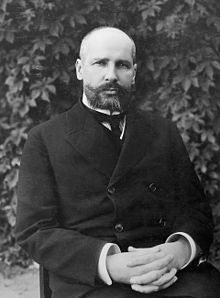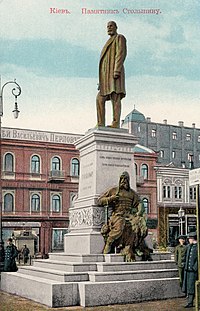Pyotr Stolypin
Pyotr Stolypin | |
|---|---|
 | |
| 3rd Prime Minister of Imperial Russia | |
| In office 21 July 1906 – 18 September 1911 | |
| Monarch | Nicholas II |
| Preceded by | Ivan Goremykin |
| Succeeded by | Vladimir Kokovtsov |
| Personal details | |
| Born | 14 April 1862 Dresden |
| Died | 18 September 1911 (aged 49) Kiev |
| Nationality | Russian |
| Spouse | Olga Borisovna Neidhardt |
Pyotr Arkadyevich Stolypin (Russian: Пётр Аркадьевич Столыпин) (14 April [O.S. 2 April] 1862– September 18 [O.S. September 5] 1911) served as Nicholas II's Chairman of the Council of Ministers—the Prime Minister of Russia—from 1906 to 1911. His tenure was marked by efforts to repress revolutionary groups, as well as for the institution of noteworthy agrarian reforms. Stolypin hoped, through his reforms, to stem peasant unrest by creating a class of market-oriented smallholding landowners.[1] He is often cited as one of the last major statesmen of Imperial Russia with a clearly defined political programme and determination to undertake major reforms.[2]
Family and background
Stolypin was born in Dresden, Saxony, on 14 April 1862. His family was prominent in the Russian aristocracy, and Stolypin was related on his father's side to the poet Mikhail Lermontov. His father was Arkady Dmitrievich Stolypin (1821–1899), a Russian landowner, descendant of a great noble family, a general in the Russian artillery and later Commandant of the Kremlin Palace. His mother was Natalia Mikhailovna Stolypina (née Gorchakova; 1827–1889), the sister of a Russian foreign minister Alexander Mikhailovich Gorchakov.
From 1869, Stolypin spent his childhood years in Kalnaberžė manor (now Kėdainiai district of Lithuania), built by his father, what remained his favourite residence for the rest of life.[3] In 1876, the Stolypin family moved to a purchased a house in Vilna for their son to study in the local Gymnasium. He received a good education at St. Petersburg University and began his service in government upon graduation in 1885, when he joined the Ministry of State Property. Four years later Stolypin was appointed marshal of the Kovno Governorate.[4] This public service gave him an inside view of the local needs and allowed to develop administrative skills. He was apparently fascinated by the common lifestyle of Northwestern provinces (especially what is now Lithuania, where his family held estates) with historically dominant privately owned single-family farmsteads and sought ways to transplant it to the rest of the Russian Empire.[5]
In 1884, Stolypin married Olga Borisovna Neidhardt, the daughter of a prominent Muscovite family, with whom he had five daughters and a son.[6]
Governor and Interior Minister
In 1902 Stolypin was appointed governor in Grodno, where he was the youngest person ever appointed to this position. He next became governor of Saratov, where he became known for the suppression of peasant unrest in 1905, gaining a reputation as the only governor who was able to keep a firm hold on his province in this period of widespread revolt. Stolypin was the first governor to use effective police methods against those who might be suspected of causing trouble, and some sources suggest that he had a police record on every adult male in his province.[7] His successes as provincial governor led to Stolypin being appointed interior minister under Ivan Goremykin.
Prime minister
A few months later, Nicholas II appointed Stolypin to replace Goremykin as Prime Minister. Russia in 1906 was plagued by revolutionary unrest and wide discontent among the population. Leftist organisations were waging campaigns against the autocracy, and had wide support; throughout Russia, police officials and bureaucrats were being assassinated. To respond to these attacks, Stolypin introduced a new court system that allowed for the arrest and speedy trial of accused offenders. Over 3,000 suspects were convicted and executed by these special courts between 1906-09.[4] The gallows hence acquired the nickname 'Stolypin's necktie'. However, to present Stolypin as just a "police autocrat" is one-sided. Stolypin believed that Russian development could only succeed through positive reforms and through the build-up on a stable and prosperous middle class.
He dissolved the First Duma on July 22 [O.S. July 9] 1906, after the reluctance of some of its more radical members to co-operate with the government and calls for land reform.[2] To help quell dissent, Stolypin also hoped to remove some of the causes of grievance amongst the peasantry. Thus, he introduced important land reforms. Stolypin also tried to improve the lives of urban laborers and worked towards increasing the power of local governments.
In July 1906 he was elected as Prime Minister. He aimed to create a moderately wealthy class of peasants, who would be supporters of societal order. (See article "Stolypin's Reform").[8]
Stolypin changed the nature of the Duma to attempt to make it more willing to pass legislation proposed by the government[citation needed].[9] After dissolving the Second Duma in June 1907 (Coup of June 1907), he changed the weight of votes more in favour of the nobility and wealthy, reducing the value of lower class votes[citation needed].[9] This affected the elections to the Third Duma, which returned much more conservative members, more willing to co-operate with the government.[2]
In the spring of 1911, Stolypin proposed a bill, which was not passed - prompting his resignation. He proposed spreading the system of zemstvo to the southwestern provinces of Russia. It was originally slated to pass with a narrow majority, but Stolypin's partisan foes had it defeated. Afterwards he resigned as Prime Minister of the Third Duma.
Assassination



In September 1911, Stolypin travelled to Kiev, despite police warnings that an assassination plot was afoot. He travelled without bodyguards and even refused to wear his bullet-proof vest.
On September 14 [O.S. September 1] 1911, while he was attending a performance of Rimsky-Korsakov's The Tale of Tsar Saltan at the Kiev Opera House in the presence of the Tsar and his two eldest daughters, the Grand Duchesses Olga and Tatiana, Stolypin was shot twice, once in the arm and once in the chest, by Dmitri Bogrov (born Mordekhai Gershkovich), who was both a leftist radical and an agent of the Okhrana. Stolypin was reported to have coolly risen from his chair, removed his gloves and unbuttoned his jacket, exposing a blood-soaked waistcoat. He sank into his chair and shouted 'I am happy to die for the Tsar' before motioning to the Tsar in his imperial box to withdraw to safety. Tsar Nicholas remained in his position and in one last theatrical gesture Stolypin blessed him with a sign of the cross. The next morning the distressed Tsar knelt at Stolypin's hospital bedside and repeated the words 'Forgive me'. Stolypin died four days after being shot. Bogrov was hung 10 days after the assassination; the judicial investigation was halted by order of Tsar Nicholas II. This gave rise to suggestions that the assassination was planned not by leftists, but by conservative monarchists who were afraid of Stolypin's reforms and his influence on the Tsar, though this has never been proven. Stolypin was buried in the Pechersk Monastery (Lavra) in Kyiv, Ukraine.
Legacy
Opinions about Stolypin's work were divided. In the unruly atmosphere after the Russian Revolution of 1905 he had to suppress violent revolt and anarchy. His agrarian reform held out much promise, however. Stolypin's phrase that it was a "wager on the strong" has often been maliciously misrepresented. Stolypin and his collaborators (most prominently his Minister of Agriculture Alexander Krivoshein and the Danish-born agronomist Andrei Andreievich Kofod) tried to give as many peasants as possible a chance to raise themselves out of poverty by promoting consolidation of scattered plots, introducing banking facilities for peasants and stimulating emigration from the overcrowded western areas to virgin lands in Kazakhstan and Southern Siberia. According to Anne Applebaum, he "gave his name to the cattle cars (Stolypinki) in which prisoners were transported to Siberia".[10]
Miscellaneous
After Stolypin's elder brother was killed in a duel, Stolypin challenged his brother’s duellist. As a result, Stolypin was wounded in the right arm, which became almost paralysed after the incident.
Stolypin's death was allegedly prophesied by Grigori Rasputin, who is reported to have shouted, "Death is after him! Death is driving behind him!" as he ran after the Imperial couple in the crowd outside the opera house.
In a TV poll to select 'the greatest Russian' in 2008, Stolypin placed second. Alexander Nevsky was first; Joseph Stalin came third.[11]
He was a keen taxidermist and had one of the largest collections of animals in the world.
References
- ^ Piotr Arkadevich Stolypin — FactMonster.com at www.factmonster.com
- ^ a b c Imperial Russia, 1815-1917 - Position Paper
- ^ http://www.kolos.lt/index.php?Itemid=28&id=202&option=com_content&task=view
- ^ a b Peter Stolypin
- ^ http://www.lrytas.lt/-12614956691260089535-vilniuje-%C4%AFam%C5%BEintas-rus%C5%B3-reformatoriaus-p-stolypino-atminimas.htm Memory of Stolypin immortalized in Vilnius
- ^ Blumberg, Arnold. Great Leaders, Great Tyrants?: Contemporary Views of World Rulers Who Made History, p. 302. Greenwood Press, 1995, ISBN 0-313-28751-1.
- ^ ::Peter Stolypin::
- ^ P.A. Stolypin and the Attempts of Reforms
- ^ a b Oxley, Peter (2001). Russia, 1855 - 1991: from tsars to commissars. Oxford University Press. ISBN 0-1991-3418-9.
- ^ Telegraph
- ^ Stalin voted third-best Russian
External links
- Template:Ru icon The ancestors Pyotr Stolypin
- "The Assassination of Pyotr Stolypin" Research collection on microfilm.
Sources
- P. A. Stolypin: The Search for Stability in Late Imperial Russia by Abraham Ascher, Stanford University Press, 2001.
- 1862 births
- 1911 deaths
- People from Dresden
- Russian nobility
- Prime Ministers of Russian Empire
- Imperial Russian politicians
- Interior ministers of Russia
- Assassinated Russian politicians
- Deaths by firearm in Ukraine
- People murdered in Ukraine
- Recipients of the Order of the White Eagle (Russian)
- Assassinated heads of government
- Russian nationalists
